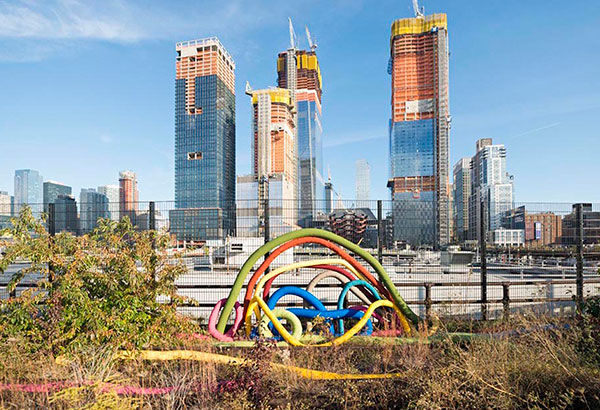Garden in the sky

Sheila Hicks’ Hop, Skip, Jump & Fly: Escape from Gravity is among the artworks at High Line.
MANILA, Philippines — With practically half a day before my late night flight out of New York, I surrendered my entire afternoon to my trusted suki driver Diebe, born in Santo Domingo of the Dominican Republic but grew up in New York, who has a Filipino neighbor who treats him as family, and vice versa. With years spent in the Big Apple, Diebe possesses an encyclopedic knowledge of all the nooks and crannies of his adopted city. He drove me to familiar downtown Manhattan, but I was in for a pleasant surprise.
I stood before a curious little elevated aged railroad simply called High Line, situated along 10th Avenue. Though unassuming from ground level – how exciting can railroad tracks be? – it metamorphosed into an entirely new venue as I ascended. There before me was a garden in the sky.
Transformed into a multidisciplinary park, this green landscape used to be a slice of a formal railway which was abandoned in 1980. Approximately one and a half miles long, this strip was resurrected in 2009 and has since breathed new life into the less glamorous Chelsea area and spurred development within the neighborhood.
This impressive greenway has been dubbed as an icon in contemporary landscape architecture. Accessible through eleven entrances from Gansevoort Street up till 34th Street – five of which are people-with-disabilities-friendly – queues are nowhere to be found due to this conscious design decision.
A public yard through and through, the area left a strong initial verdict due to the calibrated height of greens, shrubberies, wildflowers, which have grown into a wild frenzy – but somehow with a calming order brought about by its particular disorderliness.
The walkway is made of concrete and pebbles which slowly fade into and meld with the embedded pavement with little slits, where plants and weeds peep through. There are 120 different plant species in this strip – called a plant palette by its curator Dutch landscape architect Piet Oudolf – to include some never heard of before but quickly growing popular species like liatris, coneflowers, sumac and smokebush, along with mixed varieties of birch trees and cacti.
The exposed rails are likewise still evident in certain parts, which serve as a solemn reminder of years past, during its former function as transport before it was converted into the park it is today.
Small picnic pockets are often visited by families and friends, like the father-daughter bonding moment I witnessed as he was patiently demonstrating her newest toy, two chatting moms with sleeping toddlers in their pair of strollers, and groups of friends sharing meals together. I can only imagine that these sacred spaces are perfect spots to quietly lie down and read a book by day and to stargaze by night.
Soldiering on, this aerial bridge contained a series of mini twists and turns – though seldom completely deviating from the main path – and at times would end up in dead ends with single and double rows of benches, several lounges, gradual platforms and steps and amphitheater-like interstices – all set up so one can idle away and joyfully do nothing while watching the almost-remote Manhattan westside traffic below.
Far away, I caught a glimpse of an amazing view of the Hudson River, juxtaposed with the city’s skyscrapers.
As I continued my mellow saunter, I could not help but peep into the daily lives of residents through floor-to-ceiling glass windows of offices and apartments which appeared almost close enough to touch; I certainly felt like a voyeur intruding into someone’s privacy. However, it was most definitely just another day for the dwellers and just another passerby gawking in utter disbelief.
Old warehouses, as well as entire façades of new businesses, blended into the architecture and layout of High Line, as everything seamlessly became a singular living, breathing ecosystem of humans, greenery, buildings, art and machinery.
I gazed at some urban wall murals which my grandfather would call vandalism and my father graffiti, but I’ve learned to treat them as art, considering trends have evolved over the years and, with high impact or low effect, which contribute to the authentic experience of downtown New York.
As luck would have it, I happened onto an on-going outdoor installation-exhibition entitled “Mutations,” drawing inspiration from High Line itself, which explored the relationship of man and environment, where the modern advances of humans meet the undying resilience of nature.
“Sphinx Joachim” by Marguerite Humeau from France depicted a winged lion which sounded an alarm each time a body comes close. Canadian Jon Rafman’s “The Swallower Swallowed” displayed a sculpture of what appeared to be a looped food chain of a dog, whale, lizard and a human. On the other hand, Croatian Dora Budor’s “The Forecast” was a weather-responsive sculpture which changed shape and form whenever it drizzled.
Today, High Line is owned by the City of New York and maintained by community-founded non-profit conservancy Friends of the High Line, which cooperate to maintain one of the best elevated views in town that enchants five million visitors annually.
High Line was inspired by a similar greenbelt project in Paris called the Promenade plantée, a rebirth of a dilapidated railroad track into a brand new pedestrian lane.
It has now also made its very own influence in other American cities, spawning areas such as Philadelphia’s Rail Park, Atlanta’s Belt Line and Chicago’s Bloomingdale Trail, which I have since added to my ever-expanding bucket list.



















